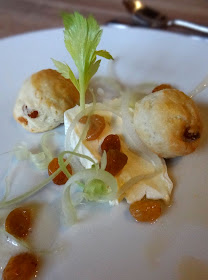With the crisp fall weather having arrived, so has the desire for warm and hearty dishes like this Cajun Shrimp Stew from Emeril Lagasse's latest cookbook, 'Sizzling Skillets and Other One-Pot Wonders'. In his tribute to single dish recipes, he shows there's nothing more satisfying than a comforting meal prepared in your most cherished pot or pan. And unlike some comfort food, this dish is warming, but not heavy. Lagasse initially gained fame in the culinary world, taking over from Paul Prudhomme as executive chef of Commander’s Palace in New Orleans, which is where he began fusing elements of French, Spanish, Caribbean, Asian, and Lagasse’s native Portuguese cuisine. Later of course, he rose to become one of television's most iconic food personalities.
Emeril Lagasse’s tribute to one-pot wonders is available on Amazon
In his recipe for Cajun Shrimp Stew, a rich homemade shrimp stock makes all the difference, and provides a fortified base for the dish. The stock starts with cooking the shells from the shrimp being used for the stew, creating a good quality aromatic fish stock with layered flavours of savoury vegetables and fresh seafood. Left to simmer for about an hour, the stock is done.
A slow simmered shrimp stock cooks for about 45 minutes
The secret to the recipe though, is getting the roux to the right colour — a little darker than peanut butter. It should take about 10 minutes, but browns quickly, so it's best to take your time. Chopped onion and garlic are then added and cooked for about 5 minutes, at which point the shrimp stock is slowly added to the roux and whisked until smooth.
The secret to the recipe though, is getting the roux to the right colour
— a little darker than peanut butter
Bay leaves, black pepper, cayenne, thyme, and salt are then added to the sauce and left to simmer for about 45 minutes. Emeril then suggests adding potatoes, but other root vegetables work well too, such as rutabaga, turnips, carrots or parsnips. Cooked for an additional half an hour, the sauce becomes rich and thick, with the shrimp added just before serving so that they stay nice and tender. Served over a bowl of hot steamed rice, and 'Bam!' as Emeril would say, you have a warm and delicious Cajun one-pot wonder.
Cajun Shrimp Stew
Serves 6-8
1 cup vegetable oil
1 1/2 cups all-purpose flour
2 1/2 cups finely chopped onion
1/4 cup minced garlic, about 12 cloves
10 cups shrimp or fish stock
2 bay leaves
1 1/4 tsp freshly ground black pepper
3/4 tsp cayenne
2 tsp chopped fresh thyme leaves
1 1/2 tbsp kosher salt
3 baking potatoes or other root vegetables, peeled and cut into 2-inch pieces
2 lb medium shrimp, peeled and deveined
1/4 cup chopped green onion, green part only
2 tbsp chopped fresh parsley leaves
Steamed long-grain rice, for serving
Heat the oil in a heavy-bottomed soup pot over medium-high heat and, when hot, add the flour. Whisk to combine and continue to cook, stirring constantly, until a medium roux is formed, about 10 minutes. It should look a bit darker than peanut butter. If the roux begins to brown too quickly, reduce the heat to medium or medium-low and take your time. It's important that the roux not be burned or the stew will have a bitter taste.
As soon as the roux is the right color, add the chopped onion and cook until soft, stirring occasionally, 4 to 6 minutes. Add the garlic and cook for 2 minutes. Stir in the stock, little by little, and bring the sauce to a gentle boil. Add the bay leaves, black pepper, cayenne, thyme, and 4 teaspoons of the salt and reduce the heat so that the sauce just simmers. Cook, stirring occasionally, until the floury taste is gone, 30 to 45 minutes.
Add the potatoes and continue to cook, uncovered and stirring occasionally, until the potatoes are very tender and the sauce is thick and flavorful, 30 to 40 minutes longer. Add a bit of water or chicken broth to thin the gravy should the stew get too thick during the cook time. The sauce is meant to be thick and rich but not pasty.
Toss the shrimp with the remaining half teaspoon of salt. Stir the shrimp, green onion, and parsley into the stew and continue to cook until the shrimp are just cooked through, 3 to 4 minutes. Remove the bay leaves and adjust the seasoning to taste if necessary. Serve in warmed bowls over hot rice.
Rich Shrimp Stock
Makes 12 cups
1 to 1 1/2 lb shrimp shells and heads
1 tbsp vegetable or olive oil
14 cups water
1 large onion, unpeeled, roughly chopped
1/2 cup roughly chopped celery
2 small carrots, roughly chopped
2 cloves garlic, peeled and smashed
2 bay leaves
1 tsp salt
2 tsp black peppercorns
3 sprigs fresh thyme
2 large sprigs fresh parsley
Rinse the shrimp shells and heads in a large colander under cold running water and allow to drain. In a large stockpot, heat the oil over medium-high heat. When hot, add the shrimp shells and cook, stirring occasionally, until the shells are pink and toasty-fragrant, 4 to 6 minutes.
Add the water and all the remaining ingredients and bring to a boil over high heat, skimming any foam that comes to the surface. Reduce the heat to medium-low and continue to cook at a slow simmer until the stock is flavourful, 45 to 60 minutes. Strain the stock through a fine-mesh sieve into a large heatproof bowl and allow it to cool completely.
Cover and refrigerate for up to 3 days before using. The stock can also be placed in airtight containers and frozen for up to several months.












































